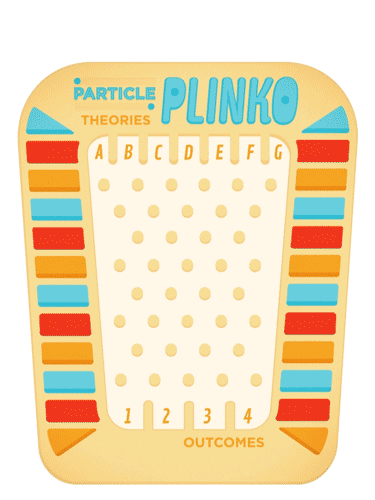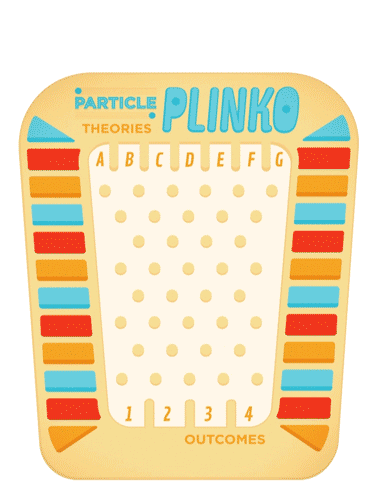In September 2010, about 100 theoretical particle physicists gathered at SLAC National Accelerator Laboratory for a workshop unique in purpose and unprecedented in scope: This group of theorists was determined to rewrite the way Large Hadron Collider data is interpreted—in effect, the way scientific discoveries are made in the realm of high-energy physics.
Until this effort began, experimentalists based their searches on detailed theoretical models, which are rigorous mathematical descriptions of natural phenomena. By pushing the math further while maintaining its internal logic, theorists have, for decades, predicted previously unobserved aspects of nature. Experimentalists then used these models to guide their searches; their results fed back into the theoretical models, which were adjusted to focus in more and more tightly on very specific predictions regarding future observations.
As proof this method can work, one need look no farther than the Standard Model, the reigning theory of how matter and energy work together at the smallest scales to make us and everything around us. The Standard Model was pieced together over decades, based on major breakthroughs by theorists and confirmed by discoveries by experimentalists. Feedback from experimentalists enabled theorists to make corrections and identify missing pieces—like the Higgs boson.
Both theorists and experimentalists are now eager to forge ahead, beyond the boundaries of the Standard Model, to new discoveries and, many hope, entirely new physics. In fact, while the search for the Higgs drew worldwide attention, other teams at the LHC were already busily combing through the mountains of ATLAS and CMS data for signs of “beyond the Standard Model” physics.
What spurred the theorists’ workshop was frustration in the search for evidence of a popular beyond-the-Standard-Model theory: supersymmetry, which partners each of the known Standard Model particles such as electrons and quarks with its own “super partner.” Supersymmetry plugs some of the remaining holes in the Standard Model in a very neat fashion.
However, scientists at the LHC and Fermilab’s Tevatron have not found results predicted by existing models of supersymmetry. That could mean that either the models are wrong, or that they’re possibly on the right track but aren’t telling researchers the right places to look. And so, in September 2010, legions of theoretical particle physicists gathered at SLAC because the experimentalists asked them to discuss new ways of combining theory and results.
The worry felt throughout the particle physics community is simple enough: No one wants to miss anything. A new tool—the LHC, the most powerful particle collider in the world—required new, more advanced experimental techniques; might it require new, more advanced theoretical ones as well? Traditional models, such as the Standard Model itself, are intrinsically top-down: “If A is correct, then B, C, D and E must happen, resulting in F, which can be experimentally observed.” Each limb followed in the decision tree pares away a multitude of branches, meaning that important evidence for new physics might never be seen.
“The models were useful initially because they allowed us all to speak the same language,” says Dave Stuart, a physics professor at the University of California, Santa Barbara, and a convener of the CMS Supersymmetry Physics Analysis Group. “The Tevatron and the LHC could directly compare results.”
But, says Bart Butler, an ATLAS collaboration member from SLAC National Accelerator Laboratory, “Models like that constrain our searches so we can’t see beyond them. We can’t see into the corners of the data because the models don’t go there.” It would be better, says Butler, to use models that “encompass as many outcomes as possible.”
Not your standard models
“They came to us privately at first,” says Jay Wacker, a theorist at SLAC and one of the organizers of the workshop. He sounds glad they did: “The LHC data is far too complicated to support arbitrary searches for new physics.”
Philip Schuster of Canada’s Perimeter Institute was another theorist approached by worried experimentalists. He agrees with Wacker that the old paradigm had outlived its usefulness. “Specific models weren’t telling us very much,” he says.
Individual theorists, Wacker and Schuster among them, began to develop the grammar and syntax of the new language the experimentalists needed. Its vocabulary was already contained in the ATLAS and CMS data as the end products of particle collisions: heavy quarks, leptons, particle jets and more.
They began to realize that they were duplicating efforts, not only in creating the new models, but in convincing the experimentalists to use them. “We’d been waging the same battle—that this was a sensible way to do it—but the experimentalists also wanted to see if there was a consensus among the entire theory community,” says Wacker.
The workshop at SLAC reassured experimentalists regarding the question of consensus. It also provided them with a collection of what are called simplified models, snapshots of particle decays, spraying jets and vanishing jots of energy that give experimentalists many more search options. These snapshots are not tied to specific theories; instead, they suggest a variety of possible explanations.
Still can’t quite picture it?
“Plinko,” says ATLAS collaborator and SLAC physicist Daniel Silverstein.
Plinko?
“The game from The Price is Right.”
In Plinko, Silverstein explains, a contestant stands at the top of a giant upright board with pegs driven into it in a grid pattern. The contestant releases a disk which bumps and skitters down the face of the board, ricocheting off pegs as it goes, until it drops into one of the bottom slots, each of which is labeled with a dollar amount.
But this isn’t Price-is-Right Plinko. This is Particle Plinko, where the disk is a proton-proton collision, the pegged board represents particle production and decay, and the slots at the bottom are the detector. The disk bounces down the board’s face, throwing off decay products as it goes, and slides into one of the slots, which are now labeled according to what experimentalists actually see: combinations of Jets, Leptons, Photons, Bottoms (as in quarks) and Taus.
In the older, top-down version of Particle Plinko, the slots at the top are labeled by model—Minimally Supersymmetric Standard Model, Extended Supersymmetry, Technicolor, Universal Extra Dimensions and more. Many, many more. The disk starts its journey in one of the top slots and once it’s bounced its way to the bottom, the slot it lands in is compared to the slot in which it began its journey to see if they match.
This would work wonderfully if particle physics actually were a Plinko game, with a well-defined board full of easily traceable paths from top to bottom instead of the devilishly complicated maze of wrong turns, dead ends, shunts and byways that it often turns out to be. The result of this complexity is many empty bottom slots—the disks never land in them.
In the simplified model version of Particle Plinko, the top of the board is masked off and new entry slots are defined much farther down, merely a bounce or two from the bottom. These new top slots are labeled by simplified model—Gluino Pair Decays to Four Jets and Missing Energy, B-Tau-Tau Resonance, and so on. The bottom slots remain untouched. This new route bypasses an extraordinary amount of complexity, and helps ensure that disks land in all the bottom slots.
Unmasking the remainder of the board and tracing a route back to the very top is still the end goal, says Butler, but he also points out that the overwhelming priority is to find “stuff.” And beginning at the bottom not only preserves more stuff, it lends itself more readily to considering unexpected explanations for how that stuff came to be.
In short, the simplified models keep open more options for discovery by looking for interesting results first and leaving the explanations for them until later, instead of starting with the explanations. Of course, that strategy brings with it its own set of challenges.
“The interpretation of the simplified models in terms of real models is not always easy,” Butler admits. “But we mostly leave that to the theorists.”
Wacker says that the use of simplified models has one big advantage over the more complete and more complex theoretical models. “It’s systematic. You can take little bits of the more complete models and fully explore them,” he says. To the charge by other theorists that simplified models require more assumptions on their end, he says assumptions are always made when interpreting experimental results.
Are the theorists signed up to reverse engineer a cosmic Plinko game?
Wacker says they are. He points to “Simplified Models for LHC New Physics Searches,” the paper that came out of the SLAC workshop. “Theory papers are usually authored by a handful of people. This paper has 90 authors on it,” he says. “We wanted to show that this is an effort of the entire theoretical community.”
Schuster sounds awed. “I’ve rarely seen so many theorists gather like that. This is a common vision, and people really worked together to make this happen.”
Model problems
The stakes are higher than many people realize. As Schuster explains, most of the supersymmetry models they’ve been following should have revealed some evidence by now. “The LHC is running, it’s getting great data, it’s found the Higgs, but it hasn’t found supersymmetry yet.”
As the saying goes, the absence of evidence is not evidence of absence. But that’s all Schuster can claim. “It’s actually hard to figure out what ‘no result’ means—really hard,” he says.
Remember those “remaining holes” in the Standard Model? Supersymmetry was proposed to help with one of the biggest of them: the hierarchy problem, the name given to the vast differences between the strengths of the fundamental forces, especially between the weak force and gravity. The Standard Model alone cannot explain these differences; for example, calculations based on the Standard Model tell theorists the Higgs should be much heavier than it turned out to be. Without something like supersymmetry to simplify the math, incredible amounts of fine-tuning are required to make the theoretical mass of the Higgs match what was found at the LHC.
Theorists don’t like to fine-tune the math. “The problem people have been speculating about for 25 years has hit us in the face,” says Schuster.
The experimentalists don't like it either. “The hierarchy problem is the reason supersymmetry was invented,” says Butler. “If it doesn’t solve that, there’s a problem.”
Model citizens
Whether or not simplified models lead to experimental evidence for supersymmetry or to something else, both sides seem more or less happy with their new, closer partnership.
Both the ATLAS and CMS collaborations are busy implementing simplified models in their search strategies. “They gained traction really quickly,” says Butler. “Two years ago no one was using them.” But now, he continues, “People realize that simplified model searches are our best shot at seeing something.”
Butler and his colleagues have also discovered that simplified models offer more than just an expanded search strategy. They speak the experimentalist’s language. As he explains, “We look for physical objects, like jets and missing energy”—which essentially describes what simplified models present.
“They also help us understand what we find,” says Jeffrey Richman, a colleague of Stuart’s at the University of California, Santa Barbara, and a former convener of the CMS Supersymmetry Physics Analysis Group. “We can look at the simplified models and see what they say about our discoveries.” Both experiments can devise their own models and refine existing ones, as well.
Wacker sees the 2013 shutdown as a “natural time” for the two groups to take stock. The experimentalists will be ready. “The lines of communication are wide open,” says Butler.
In fact, CMS member Stuart recalls a recent joint discussion between theorists and experimentalists at Canada’s Perimeter Institute for Theoretical Physics with some fondness. “There were about equal numbers of theorists and experimentalists talking.” He pauses. “That was a lot of fun.”
No point in going overboard, though, says experimentalist Butler. “We still don’t give them previews of our data.”
In this video, Jay Wacker, theoretical particle physicist at SLAC and one of the driving forces behind the development of simplified models, talks about what drew him to physics, the puzzle of dark matter, and how much he loves his job.









